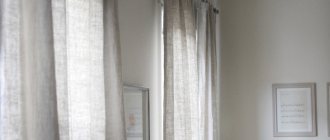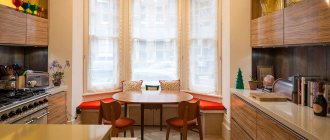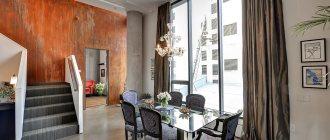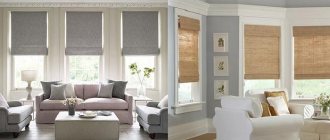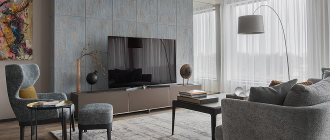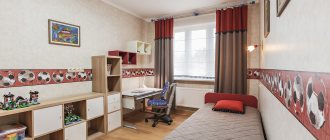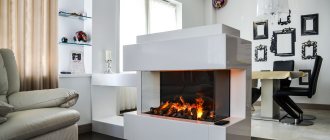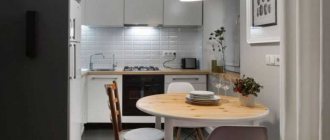Kinds
These designs are divided into three types:
- Classic. The most versatile option. Such models are a solid fabric fabric, which, when lifted, forms even horizontal folds.
- Double. Consist of two cuts, light and denser fabric. Designs of this type create a very interesting effect, both on a plastic window and on a wooden one.
- Cascade. They form a fabric cascade along the entire length of the curtain and retain folds even when unfolded.
The photo shows the interior of the kitchen and double Roman blinds on the window opening.
Curtains with original folds
Classic kitchens do not welcome ruffles, flounces, or decorative folds. However, there is always room for exceptions to the rules. Manufacturers of Roman blinds offer their customers a new product on the textile market: Roman curtains with interesting folds that are formed when the fabric is assembled.
Such models can be found today in any specialized store, ordered by a craftsman, or sewn yourself. Textured cord, beautiful satin ribbons or bows are used as auxiliary accessories.
What curtain fabric is best to use in the kitchen?
First of all, when choosing, you need to take into account all the specifics of the kitchen. Roman lifting fabrics made of mixed or natural fabrics, such as linen, organza, cotton or silk, as well as bamboo models, would be appropriate here.
Rules of care
To facilitate the cleaning procedure, use a brush. If this rule is not followed, stains will soon appear on the fabric and its structure will be disrupted. To facilitate the maintenance procedure, it is recommended to use materials with impregnations: anti-dust, water-repellent, antimicrobial. This type of fabric withstands contact with dirt and grease much better and does not absorb strong odors.
The fabric does not lose its shape and remains beautiful for a long time if you follow the rules for caring for it:
- Cleaning of the canvas is carried out once a week. Moreover, it is not recommended to wet the brush: it leaves streaks.
- Heavy dirt can be removed using a furniture attachment or vacuum cleaner. If there is a stove next to the window, the curtain is pulled back while cooking.
- Products without impregnation are washed every season or 1-2 times a year, depending on the intensity of contamination.
Washing synthetic materials is allowed at temperatures up to +40°C. Natural fabrics can withstand higher temperatures. When choosing a washing mode, take into account the structure of the material. In most cases, +60°C is considered sufficient.
Natural fabrics without synthetic additives will not last long if they are washed frequently in hot water.
Decoration in various styles
Roman blinds will be a very harmonious addition to the kitchen in various styles.
Modern (minimalism, loft)
For such interiors, classic, laconic options are suitable, without unnecessary patterns or designs. With their clear lines, they will create the effect of soft, diffused light, emphasizing the freedom and functionality of the space.
Provence
The classic design is short, light or thick curtains made from natural materials, with various patterns and a number of decorative elements inherent in the Provence style.
Classic
Roman curtains, combining practicality and elegance, will perfectly complement the overall look of a kitchen in the classic and neoclassical style, adding zest to it and creating the necessary accents.
The photo shows burgundy-colored Roman curtains in a classic-style kitchen interior.
Mechanism and principle of operation
Curtains differ not only in the type of design and fastening, but also in the mechanism that raises and lowers the fabric panel. The mechanism itself is hidden in the cornice. It can be open or closed. Most often, the cornice is sold complete with the canvas itself, but if you are sewing yourself, you can purchase it separately.
Open lift system
Closed lifting system
According to the mechanism of operation, there are three types of cornice:
- manual is the simplest, you can even do it yourself due to the elementary principle of operation. Along the back side of the canvas there is a rope threaded through special rings. When folded, folds are formed in place of these rings. There is only one drawback - it is not suitable for fabric heavier than 5 kg;
- mechanical - is a chain-rotor mechanism with a lifting shaft. The folding and unraveling of the fabric occurs using a chain. This is the most common mechanism for Roman blinds, supporting fabrics up to 8 kg;
- electric - repeats the mechanical mechanism, but is equipped with a motor that allows you to control the blade remotely. The most expensive type of cornice, which is suitable for any curtains.
The presence of a cornice involves drilling into the wall to attach a Roman blind. But there is an alternative way without new holes.
Installation without drilling
Drilling into a wall to hang a cornice is a common occurrence and is beyond doubt. But if you want to hang a canvas on the frame or sash of a plastic window, they arise and often force you to abandon such an idea. You shouldn't do this, because there are several ways to fix Roman blinds even without drilling.
Velcro is one such method. Ordinary textile Velcro, which is sometimes used in clothing and shoes, will come in handy. It is glued to the wall, window sash or frame. The second part is sewn to the fabric.
You can also glue Velcro to the fabric, but thread is more reliable. The main thing is to choose a fabric that is not heavy, since over time this method of fastening loses its reliability. An additional advantage is that the canvas is easier to care for - it can be easily removed and re-hung.
If you already have a cornice from ordinary curtains , then sew a Roman blind with loops for the existing cornice yourself. But it’s worth honestly noting that this option looks quite simple and is not suitable for classic-style kitchens.
Also, the canvas can be attached to the cornice using the same Velcro or even a stapler. If the Velcro option can somehow be justified, then attaching the fabric to the curtain rod with a stapler is undesirable, since the curtain will be considered disposable - it cannot be carefully removed for washing.
Options for mounting location
To determine the mounting option, you need to decide what tasks they should perform.
- On window sashes. Curtains are attached directly to the doors themselves and, when lowered, do not cover the window sill or tabletop. This option does not interfere with the free opening of the window.
- On the window opening. This type of curtain fastening visually expands the window frame and hides all its shortcomings.
The photo shows a kitchen and patterned Roman curtains with an option for mounting on a window opening.
How to attach
For any curtains, the main tasks are the same:
- protection from the sun and the curiosity of passers-by;
- interior decoration.
Regardless of where the canvas is attached, it will perform these functions. There are several options for what to attach to:
|
|
|
|
If the window sill will be used as a work area, it is better to choose the first or second mounting option so that the fabric does not interfere with cooking. It is worth paying attention to this type of fastener and, if you wish, storing something on the windowsill and growing greens on it.
If it is important to hide the slopes, then the cornice is mounted on the wall. This option is suitable for large windows when the use of additional decor is not planned. Ceiling fasteners are not used in the kitchen due to their impracticality.
Ideas for combining with tulle
Windows decorated in this way look very interesting and unusual. To combine with tulle, it is better to choose Roman blinds made from natural fabrics of medium density.
In the photo, windows with light Roman blinds along with tulle give the kitchen interior lightness and airiness.
Paper Roman canvases
Another new product on the textile and curtain market is Roman curtains based on a paper screen. In practice, a fairly dense base is used, on which a relief pattern is often applied. Such screens, due to their instability to moisture, must be replaced when dirty.
However, adjustment of the lifting height of the canvas is also done by using a rotating mechanism. The design of paper Roman blinds for the kitchen can be very diverse: from a completely smooth canvas to relief embossing on the surface of the paper.
Non-standard solutions in the kitchen interior
They favorably highlight the dignity and originality of the room and introduce a touch of novelty into the interior.
With balcony door
Roman blinds for the kitchen with a door to the balcony, thanks to the convenient length adjustment, will be an excellent option for the balcony opening. They will not interfere with the functioning of the door and the exit to the loggia.
The photo shows a spacious kitchen with a balcony opening decorated with green Roman blinds.
With bay window
This design looks very elegant and neat and does not overload the bay window.
The photo shows white Roman blinds with patterns on the bay windows.
On a small window
Canvases of a simple cut can especially elegantly decorate a small window opening, and when completely lowered, visually increase its size.
Material
Roman blinds can be made from any fabric - from tulle to velvet. The division often goes like this:
- natural;
- synthetic;
- mixed.
There are increased demands on fabrics in the kitchen, since this is where food is prepared.
The material should not absorb water and odors, fade in the sun, or attract dust. Since practicality comes first, it is better to choose a material with special impregnation. The disadvantage is that such fabrics cannot be washed - only dry care is acceptable.
Let's start with popular synthetic materials. The most commonly used are polyester and acrylic : they do not wrinkle, do not attract dirt, are easy to wash and dry - almost ideal for the kitchen. But there are also disadvantages - they can deteriorate if they come into close contact with heating devices. And the main disadvantage is that they look cheap.
Natural fabrics, on the contrary, look very beautiful. Linen, silk, cotton, bamboo can often be found in the kitchen because of their naturalness and naturalness. They are easy to clean, but not all stains and odors can be removed. In addition, their service life is much shorter, since natural fabric wears out faster and fades in sunlight.
The ideal option is a mixed fabric. Most often these are organza and taffeta . The mixed material exhibits the advantages of the two previous options: it looks beautiful and is used practically.
You can also find “wooden” curtains made of bamboo, but they are not entirely practical because they accumulate dust, which is difficult to clean.
Design and drawings on curtains
Various curtain designs are an integral part of any room interior.
- Flowers. Curtains decorated with floral patterns will add special chic, romance and elegance to the kitchen.
- Patterns and ornaments. They allow you to give the room a more interesting and fresh look, make the interior original and tie it into a single whole.
- Geometric pattern (stripe, checkered). Using canvases with geometric prints, you can create an unusual, catchy and extravagant design.
- Plain. These models fit more easily into a room in almost any style and have a simple, but at the same time very elegant look.
- Transparent and translucent. Such Roman blinds have an insignificant degree of protection from sunlight and, as a rule, are simply a beautiful window decoration.
The photo shows plain Roman blinds in the interior of a modern kitchen.
The photo shows a country-style kitchen with checkered Roman curtains on the window.
Light transmittance
Technically, Roman blinds can be made from any fabric, because they do not have any special tasks. They do not need to drape beautifully, form graceful vertical folds or flounces - everything is decided by the frame. Therefore, the finest lace fabric and dense impermeable fabric are equally suitable.
Sheer curtains
If there is always not enough light in the room or you want to preserve it completely, choose transparent curtains. Tulle or organza with other fibers interwoven or burnt patterns looks interesting. And plain light curtains will be almost invisible, but will protect the room from dust and insects.
Translucent curtains
Such fabrics are good if the light level in the room constantly changes during the day. Chameleon fabrics that change shade depending on the amount of light look interesting. During the day they become translucent and hide the apartment from direct sunlight, and in the evening they seem almost invisible.
Blackout curtains
If there is too much sun in the room, you prefer comfort or want to completely isolate yourself from the outside world - choose dense, opaque fabrics. Light-proof Roman blinds are more noticeable, so they will become a full-fledged independent accessory. You can even make an imitation of an antique tapestry on the window.
Turquoise color in the interior: 100 photos and design ideas
Color spectrum
The choice of colors for curtains primarily depends on the style and design of the room.
- Green. Brings a fresh and energetic atmosphere to the kitchen interior and gives it a second wind.
- Yellow. This color creates a bright, sunny and cheerful design and significantly transforms the room.
- Burgundy. The color of ripe cherries is capable of giving the kitchen a luxurious and respectable look with its splendor.
- Blue. It adds airiness and lightness to the interior, envelops it in coolness and creates a unique atmosphere.
- Beige Roman blinds are perfect for a small kitchen. They create a feeling of space.
- Brown. A comfortable and elegant color that can preserve the atmosphere of home comfort.
- Lilac. A delicate lavender shade brings calm, tranquility to the room and gives it an extraordinary appearance.
- Orange. Fills the space with sun and warmth.
The photo shows green Roman curtains with patterns in the kitchen interior.
The photo shows a small kitchen and a window opening, decorated with classic Roman blinds in beige tones.
How to choose
Choosing curtains is a responsible and important matter. To better prepare for it, you need to know a few nuances.
Dimensions
Before you go to the store, you need to decide what size curtains you need. To do this, measure the width and height of the window opening.
- If a wall mount is chosen, then the curtain should be 10–20 centimeters wider than the opening - more can be done if, for example, it is necessary to hide a pipe from a radiator. The length is chosen at the request of the owner: standardly it is 10 centimeters below the window sill.
- If it is mounted on a frame or sash, the curtain should be smaller than the window opening for comfortable use. The length is chosen such that there is about 2 centimeters left from the end of the unraveled fabric to the window sill. The gap on the sides should also be 1–2 centimeters.
Fabric characteristics
In addition to size, there are some other characteristics that are important in the kitchen: you should choose only mixed fabric, since it is considered the most practical - it is easy to wash and retains its presentable appearance for a long time.
It is worth deciding on the density of the material and its ability to transmit or, conversely, block sunlight. The more light enters the kitchen, the denser the fabric should be.
Based on light transmittance, fabrics can be divided into the following types:
- blackout - complete blocking of sunlight. The only possible loophole is on the sides if the frame mounting method is chosen. Rather intended for the bedroom for a more comfortable sleep. Rarely used in the kitchen;
- dimout - blocking sunlight by 70%. You rarely see them in the kitchen and other non-residential premises. But they can be a salvation if the windows face the sunny side or a street heavily lit by lanterns;
- day-night - the peculiarity of these curtains is in their cut - the canvas consists of alternating transparent and opaque stripes. This fabric allows you to regulate the amount of incoming light, but not everyone will like this option in appearance;
- translucent - such a canvas does not retain sunlight, but scatters it. This is the most popular and optimal decor for the kitchen. If desired, it is supplemented with a curtain.
If the kitchen is on the ground floor, it is better to choose thick fabric, regardless of which side the windows are located on and how much light comes in.
Where can I buy
There are two options for purchasing Roman blinds - buy ready-made or have them sewn to order. Each has both advantages and disadvantages.
On the one hand, it is much easier to purchase ready-made curtains, but you also need to choose them by size, style, color and pattern. There are no such problems with a “custom” canvas if there is an idea of the specific design that is expected to be seen in the kitchen.
If you want something simple and neutral, you should go to the store, if your soul requires individual beauty - only to order.
The advantage of ready-made store-bought curtains is their impregnation, which will protect the fabric from fading, moisture and ordinary dirt and soot. If appearance is more important than practicality, as, for example, in a classic kitchen, you should go to an atelier. The disadvantage of the atelier is that you will have to wait at least a few days for the curtains and set aside a day for the measurer to arrive.
Don’t forget about the option of sewing Roman blinds with your own hands. The following video will help with this.
Roman blinds step by step instructions
Decor of kitchen Roman curtains
Interesting decor provides an opportunity to give the window opening and the entire room a new look and appeal.
- Ribbon. Various ribbons can create a playful or sophisticated curtain arrangement that is sure to attract attention.
- Lambrequin. A very effective way of design. A soft or hard bandeau lambrequin goes well with Roman designs and gives the whole room a formal look.
- With edging. Contrasting black or red edging will emphasize the shape of the curtain drapery and emphasize the window opening.
Types of fastening
There are many ways to arrange Roman shades. They are attached to the sash, eyelets, Velcro, hinges or rings. More complex mechanisms are also used. As a rule, branded metal curtain rods with a built-in lifting device are used. There are several main types on sale:
- Classic – the size limit here is up to one and a half meters in width and up to about two meters in length. The most common curtain rods, suitable for most common requests.
- Skos – for objects of non-standard shape, those that have bevels, inclined surfaces.
However, you can save money on a store-bought curtain rod. There are other options. The simplest mounting technique is Velcro. One part of it needs to be glued to a homemade semblance of a cornice, the other to the fabric. With this fastening, the drapery will be easy to remove, for example, for cleaning.
